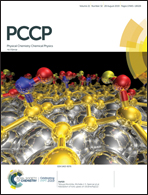The effect of covalently bonded aryl layers on the band bending and electron density of SnO2 surfaces probed by synchrotron X-ray photoelectron spectroscopy†
Abstract
Tin(IV) dioxide (SnO2) is a technologically important transparent conducting oxide with high chemical stability. In air, the SnO2 surface is terminated with hydroxyl groups which cause the electronic bands to bend downward at the surface capturing a two-dimensional surface electron accumulation layer (SEAL). The SEAL promotes adsorption at the surface, giving environmentally-sensitive electronic properties; this sensitivity is a barrier to some potential applications of the material. This work investigates surface modification of SnO2via reaction with an aryldiazonium salt as a route to controlling the surface band bending. We compare the surface layers formed by reaction at open-circuit potential and under potential control of 4-(trifluoromethyl)benzene diazonium ions with moderately- and highly-doped (101) SnO2 thin films grown by plasma-assisted molecular beam epitaxy. Atomic force microscopy and synchrotron X-ray photoelectron spectroscopy (XPS) measurements demonstrate that both reaction conditions lead to covalently-attached 4-(trifluoromethyl)phenyl groups, with grafting at open-circuit potential giving thinner layers (<2 nm) and fewer direct bonds to the surface than electrografting (layer thickness >3 nm). Valence band investigations show that for all samples the 4-(trifluoromethyl)phenyl layers decrease the surface downward band bending with the greatest effect observed for the electrografted sample. In the latter case, a +0.29 eV shift in band bending relative to that of the unmodified material indicates the success in turning the surface electron accumulation layer into a depletion layer.



 Please wait while we load your content...
Please wait while we load your content...